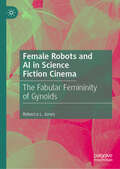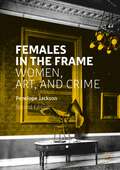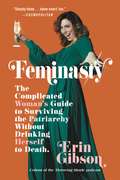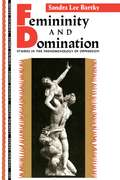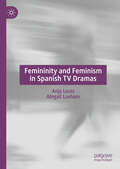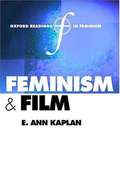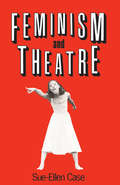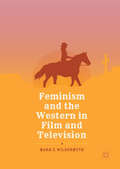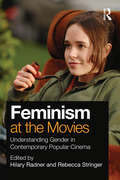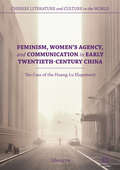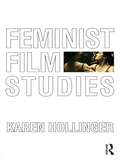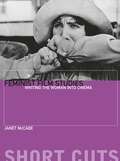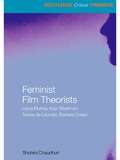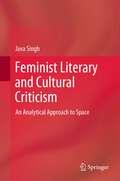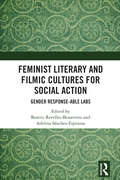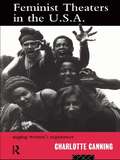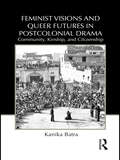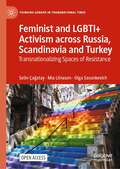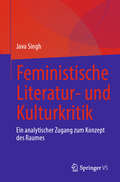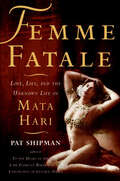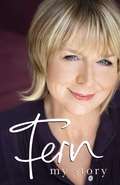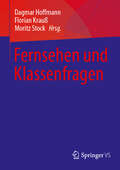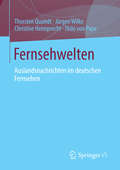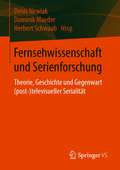- Table View
- List View
Female Robots and AI in Science Fiction Cinema: The Fabular Femininity of Gynoids
by Rebecca L. JonesThis book is the first comprehensive overview of the history of female-presenting AI and robots in US and UK live-action, science fiction films from 1949 to 2023. It offers an original taxonomy that aids in the examination of 80 films and over 135 characters&’ representations, starting with The Perfect Woman (1949) and ending with Robots (2023). Using its representational taxonomy, this book analyses the evolution of these depictions, showing the continuations, revisions, and shifts in the depiction of female-presenting AI and robots from objectified, eroticised, subordinated things to being autonomous moral agents who assert their right to equality and refuse their abusive, typically sexual, use. This book shows how these fictional, gendered constructions are products of a heterosexual, cisgender, male fantasy of an idealised, subordinated form of femininity. These artificial characters, along with their real-world counterparts, highlight a desire for a subordinated femininity, but also show how that subordination is a social construction often reinforced and countered in onscreen depictions. By examining the trends within its asserted Galatea, Girlfriend, Mother, and Deadly Seductress types, this book presents an exploration of what our female-presenting artificial creations could be, while addressing their contemporary, and our current, AI technologies, and how science fiction is influencing real life, while our reality seeks to mirror science fiction.
Females in the Frame: Women, Art, and Crime
by Penelope JacksonThis book explores the untold history of women, art, and crime. It has long been widely accepted that women have not played an active role in the art crime world, or if they have, it has been the part of the victim or peacemaker. Women, Art, and Crime overturns this understanding, as it investigates the female criminals who have destroyed, vandalised, stolen, and forged art, as well as those who have conned clients and committed white-collar crimes in their professional occupations in museums, libraries, and galleries. Whether prompted by a desire for revenge, for money, the instinct to protect a loved one, or simply as an act of quality control, this book delves into the various motivations and circumstances of women art criminals from a wide range of countries, including the UK, the USA, New Zealand, Romania, Germany, and France. Through a consideration of how we have come to perceive art crime and the gendered language associated with its documentation, this pioneering study questions why women have been left out of the discourse to date and how, by looking specifically at women, we can gain a more complete picture of art crime history.
Feminasty: The Complicated Woman's Guide to Surviving the Patriarchy Without Drinking Herself to Death
by Erin GibsonFrom the wickedly famous and feminist creator and host of the "Throwing Shade" podcast, a collection of hilarious personal essays and political commentary perfect for fans of Lindy West and Roxane Gay. Since women earned the right to vote a little under one hundred years ago, our progress hasn't been the Olympic sprint toward gender equality first wave feminists hoped for, but more of a slow, elderly mall walk (with frequent stops to Cinnabon) over the four hundred million hurdles we still face. Some of these obstacles are obvious-unequal pay, under-representation in government, reproductive restrictions, lack of floor-length mirrors in hotel rooms. But a lot of them are harder to identify. They're the white noise of oppression that we've accepted as lady business as usual, and the patriarchy wants to keep it that way.Erin Gibson has a singular goal-to create a utopian future where women are recognized as humans. In FEMINASTY-titled after her nickname on the hit podcast "Throwing Shade"-she has written a collection of make-you-laugh-until-you-cry essays that expose the hidden rules that make life as a woman unnecessarily hard and deconstructs them in a way that's bold, provocative and hilarious. Whether it's shaming women for having their periods, allowing them into STEM fields but never treating them like they truly belong, or dictating strict rules for how they should dress in every situation, Erin breaks down the organized chaos of old fashioned sexism, intentional and otherwise, that systemically keeps women down.
Femininity and Domination: Studies in the Phenomenology of Oppression
by Sandra Lee BartkyBartky draws on the experience of daily life to unmask the many disguises by which intimations of inferiority are visited upon women. She critiques both the male bias of current theory and the debilitating dominion held by notions of "proper femininity" over women and their bodies in patriarchal culture.
Femininity and Feminism in Spanish TV Dramas
by Anja Louis Abigail LoxhamRecent social and political events in Spain have prompted a resurgence of feminism in the Spanish public sphere. Popular culture intervenes in these debates, and television does so specifically through the dramas which foreground female stories and female subjects, in many cases redefining and interpreting key moments in the progression of national gender politics. This pioneering study maps these developing concerns onto a selection of TV dramas which centre on feminisms and female identities, and as such are key interlocutors in social change. Our intention is to mainstream Spanish television studies and, in our analysis of its innovative and varied approach to gender politics, to take it out of the ‘interpretative isolation ward’ (Smith 2006). This monograph fills a significant gap in the literature on transnational popular culture; it is ground-breaking in its interdisciplinarity (television, modern languages, gender studies) and is the first of its kind in English.
Feminism and Film (Oxford Readings in Feminism Series)
by E. Ann KaplanThis book brings together carefully selected essays on feminism and film with a view to tracing major developments in theory, criticism, and practices of women and cinema from 1973 to the present day. It illuminates the powerful, if controversial, role feminist research has played in the emergence of Film Studies as a discipline during these years; reprinting influential 1970s pioneering essays tracing the ensuing debates and challenges to key theories that shaped this field in the next two decades. Kaplan details the Euro-American contexts within which feminist film theories and practices emerged and traces the changing influences of French, German, and American intellectual movements on feminist film research. As well as a wide-ranging introduction which sets the selection of essays in context, readers will find examples of social-role, psychoanalytic, structuralist, post-structuralist, gay and lesbian, postmodern and postcolonial feminist film criticism, prefaced by introductory notes and including further readings.
Feminism and Theatre
by Sue-Ellen CaseThis classic study is both an introduction to, and an overview of, the relationship between feminism and theatre.
Feminism and the Western in Film and Television
by Mark E. WildermuthThis book works to complicate and push against common arguments that the Western from its inception is an anti-feminist genre. By focusing on representations of women professionals in Westerns, it shows that women in cinematic and televisual Westerns sometimes do acquire agency and empowerment in the private and public realms, despite our culture’s tendency to gender the former as feminine and the latter as solely masculine. The study reviews the relationship of these progressive Westerns to both explicit and latent feminist ideologies relevant to their times, as the films evolved from the 1930s to the twenty-first century.
Feminism at the Movies: Understanding Gender in Contemporary Popular Cinema
by Hilary Radner Rebecca StringerFeminism at the Movies: Understanding Gender in Contemporary Popular Cinema examines the way that contemporary film reflects today’s changing gender roles. The book offers a comprehensive overview of the central issues in feminist film criticism with analyses of over twenty popular contemporary films across a range of genres, such as chick flicks, teen pics, hommecoms, horror, action adventure, indie flicks, and women lawyer films. Contributors explore issues of femininity as well as masculinity, reflecting on the interface of popular cinema with gendered realities and feminist ideas. Topics include the gendered political economy of cinema, the female director as auteur, postfeminist fatherhood, consumer culture, depictions of professional women, transgender, sexuality, gendered violence, and the intersections of gender, race, and ethnic identities. The volume contains essays by following contributors: Taunya Lovell Banks, Heather Brook, Mridula Nath Chakraborty, Michael DeAngelis, Barry Keith Grant, Kelly Kessler, Hannah Hamad, Christina Lane (with Nicole Richter), JaneMaree Maher, David Hansen-Miller (with Rosalind Gill), Gary Needham, Sarah Projansky, Hilary Radner, Rob Schaap, Yael D Sherman, Michele Shreiber, Janet Staiger, Peter Stapleton, Rebecca Stringer, Yvonne Tasker, and Ewa Ziarek.
Feminism, Women's Agency, and Communication in Early Twentieth-Century China: The Case of the Huang-Lu Elopement (Chinese Literature and Culture in the World)
by Qiliang HeFeminism, Women’s Agency, and Communication in Early Twentieth-Century China focuses on a sensational elopement in the Yangzi Delta in the late 1920s to explore how middle- and lower-class members of society gained access to and appropriated otherwise alien and abstract enlightenment theories and idioms about love, marriage, and family. Via a network of communications that connected people of differing socioeconomic and educational backgrounds, non-elite women were empowered to display their new womanhood and thereby exercise their self-activating agency to mount resistance to China’s patriarchal system. Qiliang He’s text also investigates the proliferation of anti-feminist conservatisms in legal practice, scholarly discourses, media, and popular culture in the early Nanjing Decade (1927-1937). Utilizing a framework of interdisciplinary scholarship, this book traverses various fields such as legal history, women’s history, popular culture/media studies, and literary studies to explore urban discourse and communication in 1920s China.
Feminist Film Studies
by Karen HollingerFeminist Film Studies is a readable, yet comprehensive textbook for introductory classes in feminist film theory and criticism. Karen Hollinger provides an accessible overview of women’s representation and involvement in film, complemented by analyses of key texts that illustrate major topics in the field. Key areas include: a brief history of the development of feminist film theory the theorization of the male gaze and the female spectator women in genre films and literary adaptations the female biopic feminism and avant-garde and documentary film women as auteurs lesbian representation women in Third Cinema. Each chapter includes a "Films in Focus" section, which analyzes key texts related to the chapter’s major topic, including examples from classical Hollywood, world cinema, and the contemporary period. This book provides students in both film and gender/women’s studies with a clear introduction to the field of feminist film theory and criticism.
Feminist Film Studies: Writing the Woman into Cinema
by Janet MccabeJanet McCabe is a lecturer in film studies at Trinity College, Dublin. She writes on feminist film theory and women's narrative/narration in quality American television.
Feminist Film Studies: Writing the Woman into Cinema (Short Cuts)
by Janet McCabeAn introduction to feminist film theory as a discourse from the early seventies to the present. McCabe traces the broad ranging theories produced by feminist film scholarship, from formalist readings and psychoanalytical approaches to debates initiated by cultural studies, race and queer theory.
Feminist Film Theorists: Laura Mulvey, Kaja Silverman, Teresa de Lauretis, Barbara Creed (Routledge Critical Thinkers)
by Shohini ChaudhuriFocusing on the ground-breaking work of Laura Mulvey, Kaja Silverman, Teresa de Lauretis and Barbara Creed, this book explores how, since it began in the 1970s, feminist film theory has revolutionized the way that films and their spectators can be understood. Examining the new and distinctive approaches of each of these thinkers, this book provides the most detailed account so far of their ideas. It illuminates the six key concepts and demonstrates their value as tools for film analysis: the male gaze the female voice technologies of gender queering desire the monstrous-feminine masculinity in crisis. Testing their ideas with a number of other examples from contemporary cinema and TV, Shohini Chaudhuri shows how these four thinkers construct their theories through their reading of films. An excellent study companion for all students of film theory and women’s studies.
Feminist Literary and Cultural Criticism: An Analytical Approach to Space
by Java SinghFeminist Literary and Cultural Criticism explores inter-disciplinary connections across Cultural Anthropology, Geography, Psychology, and feminist literary criticism to develop a theoretical framework for spatial criticism. Using the spatial gynocritics framework developed in the book, it analyzes selected texts from five different genres–short-story, novel, film, cartoons, and OTT series, created by women. The creators discussed in the book constitute a transnational collectivity of women that shares common concerns about gender, environment, technology, and social hierarchies. They comprise a geographically and linguistically diverse group from India, Uruguay, Spain, Argentina, and the USA. The book offers immense potential for a comparative study on numerous aspects, among which the present work concentrates on the treatment of Space, demonstrating that spatial logic and grammar are essential elements of the feminist praxis. The book reveals the unexamined potential in the women creators’ praxis of destabilizing, decentring, and destroying the ascribed centres around which social arrangements are structured. Moreover, the book offers valuable analytic tools that add to scholarship in literary theory, comparative cultural studies, comparative literature, gender studies, feminist criticism, and interdisciplinary humanities. It is an indispensable aid to students and faculty in these areas of study, enabling them to critique texts from a fresh perspective.
Feminist Literary and Filmic Cultures for Social Action: Gender Response-able Labs
by Beatriz Revelles-Benavente Adelina Sánchez-EspinosaFeminist Literary and Filmic Cultures for Social Action: Gender Response-able Labs examines teaching and research practices under feminist new materialisms, affect theories and response-ability through literary and visual products, and offers possible bridges between academia and activism to create feminist interventions in contemporary neoliberal structures.Featuring chapters from contributors across a wide range of disciplines, this book follows a methodological framework that blends traditionally opposite categories, such as theory and practice, and explores contemporary literature and films as case studies within innovative “feminist response-able labs”.In Feminist Literary and Filmic Cultures for Social Action readers will encounter a collaborative trans-disciplinary toolbox which can be of use to multiple disciplines and an invaluable resource to advanced undergraduate students, postgraduate researchers and scholars in literary studies, film studies, feminist theories, new materialisms, and affective pedagogies
Feminist Theatres in the USA: Staging Women's Experience (Gender in Performance)
by Charlotte CanningFeminist Theaters in the USA is a fresh, informative portrait of a key era in feminist and theater history It is vital reading for feminist students, theater historians and theater practitioners. Their continued movement forward will be challenged and enriched by this timely look back at the trials and accomplishments of their predecessors. Canning interviews over thirty women who took part in the dynamic feminist theater of the 1970s and 1980s. They provide first-hand accounts of the excitement, struggles and innovations which formed their experience. From this foundation Cannning constructs a compelling combination of historical survey, critique and celebration which explores: * The history of the groups and their formation * The politics which shaped their work * Their methods and creative processes * The productions they brought to the stage * The reception from critics and audiences
Feminist Visions and Queer Futures in Postcolonial Drama: Community, Kinship, and Citizenship (Routledge Advances In Theatre And Performance Studies #17)
by Kanika BatraIn this timely study, Batra examines contemporary drama from India, Jamaica, and Nigeria in conjunction with feminist and incipient queer movements in these countries. Postcolonial drama, Batra contends, furthers the struggle for gender justice in both these movements by contesting the idea of the heterosexual, middle class, wage-earning male as the model citizen and by suggesting alternative conceptions of citizenship premised on working-class sexual identities. Further, Batra considers the possibility of Indian, Jamaican, and Nigerian drama generating a discourse on a rights-bearing conception of citizenship that derives from representations of non-biological, non-generational forms of kinship. Her study is one of the first to examine the ways in which postcolonial dramatists are creating the possibility of a dialogue between cultural activism, women’s movements, and an emerging discourse on queer sexualities.
Feminist and LGBTI+ Activism across Russia, Scandinavia and Turkey: Transnationalizing Spaces of Resistance (Thinking Gender in Transnational Times)
by Mia Liinason Olga Sasunkevich Selin ÇağatayWhat do struggles for women’s and LGBTI+ rights in Russia, Turkey and the Scandinavian countries have in common? And what can actors who struggle for rights and justice in these contexts learn from each other? Based on a multisited ethnography of feminist and LGBTI+ activisms across Russia, Turkey and the Scandinavian countries, this Open Access book explores transnational struggles on various levels, from the micro-scale of the everyday to large-scale, spectacular events. Drawing on ethnographic insights and encounters from various sites, this book conceptualizes resistance as situated in the grey zone between barely perceptible, even hidden or covert, forms of mundane activist practices and highly visible street protests, gathering large crowds. Taking the reader beyond the dichotomies of visible/invisible and public/private, this book advances new understandings of resistance, solidarity, and activism in transnationalizing feminist and queer struggles, illustrated by rich ethnographic case studies from Russia, Scandinavia and Turkey.
Feministische Literatur- und Kulturkritik: Ein analytischer Zugang zum Konzept des Raumes
by Java SinghFeministische Literatur- und Kulturkritik erforscht interdisziplinäre Verbindungen zwischen Kulturanthropologie, Geographie, Psychologie und feministischer Literaturkritik, um einen theoretischen Rahmen für Raumkritik zu entwickeln. Anhand des im Buch entwickelten Rahmens der räumlichen Gynokritik werden ausgewählte Texte aus fünf verschiedenen Genres - Kurzgeschichte, Roman, Film, Zeichentrickfilm und OTT-Serie - analysiert, die von Frauen verfasst wurden. Die in dem Buch behandelten Autorinnen bilden eine transnationale Gemeinschaft von Frauen, die gemeinsame Anliegen in Bezug auf Geschlecht, Umwelt, Technologie und soziale Hierarchien teilen. Es handelt sich um eine geografisch und sprachlich vielfältige Gruppe aus Indien, Uruguay, Spanien, Argentinien und den USA. Das Buch bietet ein immenses Potenzial für eine vergleichende Studie zu zahlreichen Aspekten, von denen sich die vorliegende Arbeit auf die Behandlung des Themas Raum konzentriert und zeigt, dass räumliche Logik undGrammatik wesentliche Elemente der feministischen Praxis sind. Das Buch offenbart das ungeprüfte Potenzial der Praxis der Schöpferinnen, die zugeschriebenen Zentren, um die herum die sozialen Arrangements strukturiert sind, zu destabilisieren, zu dezentrieren und zu zerstören. Darüber hinaus bietet das Buch wertvolle Analyseinstrumente, die die Literaturtheorie, die vergleichenden Kulturwissenschaften, die vergleichende Literaturwissenschaft, die Geschlechterforschung, die feministische Kritik und die interdisziplinären Geisteswissenschaften bereichern. Es ist ein unverzichtbares Hilfsmittel für Studierende und Lehrende in diesen Studienbereichen, das es ihnen ermöglicht, Texte aus einer neuen Perspektive zu betrachten.
Femme Fatale: Love, Lies, and the Unknown Life of Mata Hari
by Pat Shipman“An engrossing biography” of the Dutch exotic dancer accused of being a spy for the Germans during World War I.In 1917, the notorious Oriental dancer Mata Hari was arrested on the charge of espionage; less than one year later, she was tried and executed, charged with the deaths of at least 50,000 gallant French soldiers. The mistress of many senior Allied officers and government officials, even the French minister of war, she had a sharp intellect and a golden tongue fluent in several languages; she also traveled widely throughout war-torn Europe, with seeming disregard for the political and strategic alliances and borders. But was she actually a spy? In this persuasive new biography, Pat Shipman explores the life and times of the mythic and deeply misunderstood dark-eyed siren to find the truth.Praise for Femme Fatale“Her life’s story is a humdinger.” —Washington Post Book World“Pat Shipman reasons (and writes) like a born counterintelligence officer. Her gripping and well-developed account of the famed spy . . . will fascinate you right down to her grim imprisonment and hast execution in a desolate field outside Paris, her last performance faced, as were all of her life’s twists and turns, with bravery and grace.” —Peter Earnest, Executive Director, International Spy Museum, Washington, D.C., and former CIA Operations Officer
Fern: My Story
by Fern BrittonThe much-loved TV star Fern Britten tells her story for the first time in her Sunday Times bestselling memoir.For years now, Fern Britton has been widely loved as the presenter ofReady Steady Cook, and, more recently, co-presenter of This Morning with Philip Schofield. Never one to shy away from a good laugh or cry on national TV, she has none-the-less never talked about herself to the public, preferring to keep her private life private. Her warmth and humour, empathy and compassion, have made her feel like a best friend to millions on a daily basis, but no one knows the woman behind the sparkling smile.Now, for the first time, she is going to tell her story. And it is one that will strike a chord with women everywhere. Life as a child was not always easy, and she faced private and public challenges with her personal life, appearance and her career as she climbed the ladder to fame. Now a full-time working mum, with a very happy marriage to her second husband Phil Vickery, she is at the top of her game, and ready to tell it like it is. So put your feet up and get ready for a great read with Fern Britten.Fern Britten grew up in Buckinghamshire, and started her career on Westward Television, before moving to GMTV and Ready Steady Cook. She later co-presented This Morning with Philip Schofield, and has become a much sought after presenter for shows including Have I Got News For You, Soap Star Superstar and Celebrity Mr and Mrs. She recently wowed audiences with her performance on Strictly Come Dancing. She lives in Buckinghamshire with her husband Phil Vickery and their four children.
Fernsehen und Klassenfragen
by Dagmar Hoffmann Florian Krauß Moritz StockDer Sammelband untersucht das Verhältnis von Klasse – einer nicht nur ökonomischen, sondern auch kulturellen und politischen Kategorie – und dem Fernsehen in seinen gegenwärtigen hybriden Formen vor allem aus vier Perspektiven: Erstens geht es um Klassenfragen im Fernsehen, auf der Ebene der Repräsentation, zweitens um Klassenfragen des Fernsehens auf der Seite der Produktion. Hier ist zum Beispiel zu analysieren, welche Klassen welches Fernsehen (für welche Klassen) entwickelt und herstellt. Unter drittens Klassenfragen beim Fernsehen fallen Beiträge, die sich auf die Seite der Rezeption fokussieren und zum Beispiel die Lesarten zu spezifischen Klassendarstellungen beleuchten. Viertens nimmt der Band Klassenfragen der Fernsehwissenschaft in den Blick und reflektiert in diesem Zusammenhang ihre Lücken und ihre Prägung durch Klassenzugehörigkeit.
Fernsehwelten
by Thorsten Quandt Jürgen Wilke Christine Heimprecht Thilo PapeDer Band vermittelt ein eindrückliches Bild vom Stand der Auslandsberichterstattung im deutschen Fernsehen. Auf der Basis inhaltsanalytischer Untersuchungen, einer Repräsentativbefragung unter deutschen Fernsehzuschauern sowie Leitfadeninterviews mit Journalisten aus den produzierenden Redaktionen werden die Erkenntnisse eines umfassenden Projekts zur Erforschung der Auslandsnachrichten im deutschen Fernsehen diskutiert.
Fernsehwissenschaft und Serienforschung: Theorie, Geschichte und Gegenwart (post-)televisueller Serialität
by Dominik Maeder Denis Newiak Herbert SchwaabFernsehserien erfreuen sich einer ungebrochenen - populären wie wissenschaftlichen - Aufmerksamkeit. Dabei erstaunt, dass in medien- und kulturwissenschaftlichen Arbeiten zur Serialität fernsehwissenschaftliche und -geschichtliche Ansätze noch immer eine eher kleine Rolle spielen. Dabei ist Serialität stets vom Fernsehen her zu denken, sind doch beide schon immer unauflösbar miteinander verwoben gewesen – ökonomisch, technisch und ästhetisch. Doch was macht darüber hinaus das Serielle im Fernsehen aus und wie verändert es sein Gesicht in Zeiten von Digitalisierung, Streaming und Interaktivität? Lässt sich eine genuine Serientheorie des Televisuellen denken – und was lässt sich daraus wiederum für die Serialität jenseits des Fernsehens lernen? Die fernsehwissenschaftlichen Aufsätze dieses Bandes leisten einen Beitrag dazu, das Serielle als Kernprinzip des Fernsehens neu zu beleuchten und anhand vielfältiger Beispiele aus dem aktuellen Fernsehserienangebot neue Impulse für eine Fernsehtheorie des Seriellen zu setzen.
